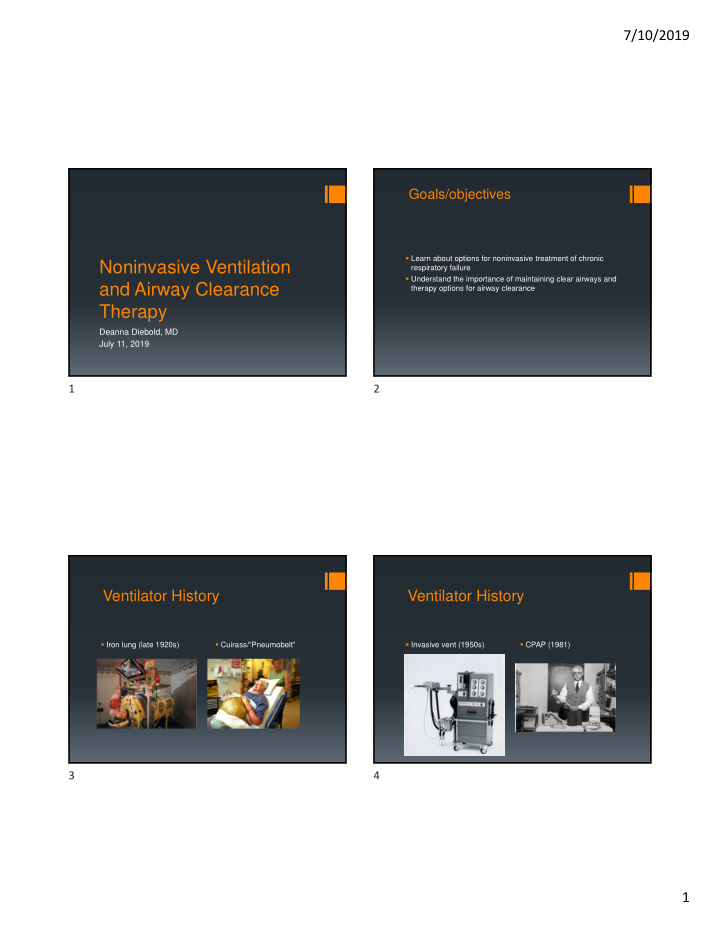



7/10/2019 Goals/objectives Learn about options for noninvasive treatment of chronic Noninvasive Ventilation respiratory failure Understand the importance of maintaining clear airways and and Airway Clearance therapy options for airway clearance Therapy Deanna Diebold, MD July 11, 2019 1 2 Ventilator History Ventilator History Iron lung (late 1920s) Cuirass/”Pneumobelt” Invasive vent (1950s) CPAP (1981) 3 4 1
7/10/2019 Neuromuscular Diseases (NMD) Neuromuscular Diseases (NMD) Result in progressive weakness of skeletal muscles Respiratory complications are the primary cause of morbidity and mortality Rapid – Myasthenic crises, Guillain-Barre Intermediate - ALS Hypoventilation (Inspiratory muscles) Airway protection (Bulbar muscles) Slow – Muscular dystrophies, SMA type 2 Other (post-Polio syndrome, kyphoscoliosis) Airway clearance (Expiratory muscles) 5 6 Nocturnal Hypoventilation Nocturnal Hypoventilation - Screening with overnight oximetry Not tightly correlated with (upright) PFTs REM-related atonia and hypopnea Decreased CNS sensitivity to hypoxemia and hypercarbia Onset is gradual, symptoms can be subtle More frequent awakenings (nocturia) Increased sleep time, daytime sleepiness AM headaches Orthopnea (especially in supine position) Daytime dyspnea is relatively rare 7 8 2
7/10/2019 NIV improves survival in DMD Nocturnal Hypoventilation 5-year survival improved from 8% (historical data) to almost 75% if patients started NIPPV when FVC <1 liter Formal diagnosis and NIV titration - PSG with transcutaneous CO2 monitoring Depending on patient preference and underlying condition, empiric NIV also acceptable Insurance requires: Neuromuscular diagnosis AND no COPD FVC <50% predicted OR MIP < -60 cm H2O OR Daytime pCO2 >45 mmHg OR Nocturnal desaturation <88% for >5 minutes Simonds et al, Thorax 1998;53:949–952 9 10 NIV improves survival in ALS NIV improves survival in ALS RCT – seemed to Retrospective favor patients with Cohort Analysis – less bulbar Bulbar patients involvement actually benefitted more Bourke SC, et. Al. Neurology. 2006;61:171-177 Berlowitz, DJ et al. J Neurol, Neurosurg, Psychiatry 2016;87:280-286 11 12 3
7/10/2019 NIV improves QoL in ALS NIV in NMD Prolongs survival Improves QoL Start at night – REM paralysis/hypoventilation Progress to daytime use OMV Bourke SC, et al. Neurology. 2006;61:171-177 13 14 Hypoventilation in COPD NIV in COPD RESCUE Trial (2014) NIV if hypercapneic >48 hours after “resolution” of ARF Settings 20/5 cwp No benefit to mortality or readmission Trend towards improved HRQoL Murphy et al (JAMA 2017) NIV if hypercapneic > 2 weeks after ARF resolution Settings 24/4 cwp Significantly improved admission-free survival 15 16 4
7/10/2019 NIV in COPD NIV in COPD Probably best in patients with persistent hypercapnia - >53 mmHg at least two weeks following exacerbation requiring NIV Use fairly high IPAP settings, goal is to normalize pCO2 Murphy, P et al. JAMA 2017 June 6; 371 (21): 2177-2186 17 18 NIV in COPD – Payment Airway clearance Daytime pCO2 (on prescribed O2) >52 mmHg AND Excessive secretions (CF, bronchiectasis) Nocturnal oximetry </=88% for > 5 minutes on at least 2 LPM Inability to close glottis (bulbar dysfunction) O2 Low TLC (inspiratory muscle weakness) OSA/CPAP has been considered and ruled out (PSG not Low Peak Cough Flow (weak expiratory muscles, chest wall required) deformity) 19 20 5
7/10/2019 Airway Clearance HFCWO – “Vest” 21 22 HFCWO – “Vest” Airway Clearance 23 24 6
7/10/2019 Airway Clearance Airway clearance Oscillating PEP valve – “Aerobika”, “Acapella” Requires intact muscle strength Requires adequate patient cooperation 25 26 Breath stacking Airway clearance in NMD Cough peak flow (CPF) >270 L/min adequate <160 L/min inadequate Maximal expiratory pressure (MEP) >60 mmHg adequate <45 mmHg inadequate Muscles temporarily become weak during acute illness 27 28 7
7/10/2019 Mechanical Insufflation- Exsufflation Mechanical I-E Settings probably +/- 40 cwp Higher pressures if using via trach Probably lower pressures and longer inspiratory times in bulbar ALS Slight concern for barotrauma if underlying parenchymal lung disease 29 30 Airway clearance - Goal Airway clearance - Goal 31 32 8
7/10/2019 Airway clearance - Goal Recap/Conclusions Noninvasive ventilation benefits patients with restrictive lung disease from neuromuscular weakness or chest wall deformities Length of life Quality of life NIV may benefit patients with severe COPD and hypercarbia Stehling et al. Chronic Resp Disease; 2015;12(1): 31-35 McKim et al, Arch Phys Med Rehabil; 2012(93) 1117-1122 33 34 Recap/Conclusions Airway clearance therapy – multiple options available Use if too many secretions or too weak to cough up secretions If weak, probably need MI-E or air stacking Maintenance therapy in the absence of acute symptoms probably has benefit 35 9
Recommend
More recommend